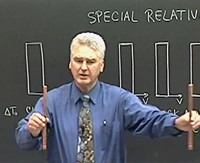
Modern Physics
Emission of Light
Various electric discharge tubes are used to demonstrate the spectrum of emitted light from excited gas atoms.

Click the image to watch the video
- Various spectral tubes
- Spectral tube power supply
- Diffraction grating with projection lens
- Light bulb with vertical filament
- Variac
- Screen
The quantum process of light emission is briefly described and the discrete spectra are demonstrated from excited hydrogen, helium and mercury gases. In another experiment, an incadescent light bulb with a vertical tungsten filament is used to demonstarte the continuous spectrum of light by a hot solid metal filament.
Fluorescence and Phosphorescence
An ultraviolet light source is used to illuminate various fluorescent materials and a visible light source is used to energize a phosphorescent ball.

Click the image to watch the video
- Various fluorescent materials
- Ultraviolet light source
- Phosphorescent ball
- Towel
- Slide projector light source
Various fluorescent materials are observed to emit visible light in a dark room while being illuminated by ultraviolet light. It is observed that when the same materials are illuminated by white light, the colors are different from when illuminated by ultraviolet light. In another experiment, a phosphorescent ball which has been kept in the dark under a towel is then exposed to white light from a slide projector. The room is darkened and the ball is observed to emit light.
Photoelectric Effect
Electrons are demonstrated to be ejected from a metal plate when the plateis illuminated by ultraviolet light, but not ejected when illuminated byvisible light.

Click the image to watch the video
- Electroscope with zinc plate attached
- Ultraviolet light source
- Slide projector light source
- Rubber rod
- Fur pad
An electroscope with a zinc plate mounted on top is charged negatively by a rubber rod. The electroscope is observed to be discharged by touching or by shining ultraviolet light on the zinc plate. When the charged electrscope is exposed to bright visible light from a slide projector, no such discharge is observed.
Radioactivity
A Geiger counter in conjunction with various absorbers is used to demonstrate radiation from radioactive sources.

Click the image to watch the video
- Geiger counter
- Various radioactive sources
- Various absorbers
The common particles emitted in radioactive decay, namely, alpha, beta, and gamma are briefly described. The detection of radiation by a Geiger counter is briefly described and demonstrated by bringing sources of radiation near the Geiger tube's window.The relative degrees of penetration of alpha, beta and gamma particles through various absorbers is separately demonstrated for three different radioactive sources.
Cloud Chamber
The tracks of radioactive particles as they pass through a cloud chamber are shown.

Click the image to watch the video
- Cloud chamber and its accessories
A cloud chamber is prepared and the mechanism for showing a radioactive particle trail is briefly described. A radioactive source of Pb-210 which is primarily a low energy beta emitter is placed at the lower center of the chamber. One of the daughter nuclei of Pb-210 is Po-210 which emits high energy alpha particles that fly through the cloud chamber. The path of these alpha particles is observed and the random nature of the radioactive decay is demonstrated.
Mickelson-Morely Experiment
A Michelson interferometer is used to demonstrate the original experiment of Michelson and Morley.

Click the image to watch the video
- Michelson interferometer
- Laser
- Rotating platform
- Screens
A Michelson interferometer and a laser source are mounted on a rotating platform. The fringes are projected onto a screen and a fringe shift is demonstrated by changing the path length of one arm. The platfrom is then rotated through 90 degrees and the fringe pattern is followed as it moves through different screens. The lack of shift in fringes for this demonstration and for the original Michelson-Morley experiment is discussed.
Time Dilation
Time dilation is illustrated using two identical light clocks in relative motion.

Click the image to watch the video
- Two metal tubes
- Stand with clamp
The fundamental principles of special relativity are briefly discussed. The well-known thought experiment involving two identical light clocks is described using metal tubes to represent the clocks. By moving one of these clocks across the chalkboard while holding the other at rest, the respective light beams are drawn on the board and time dilation is shown.